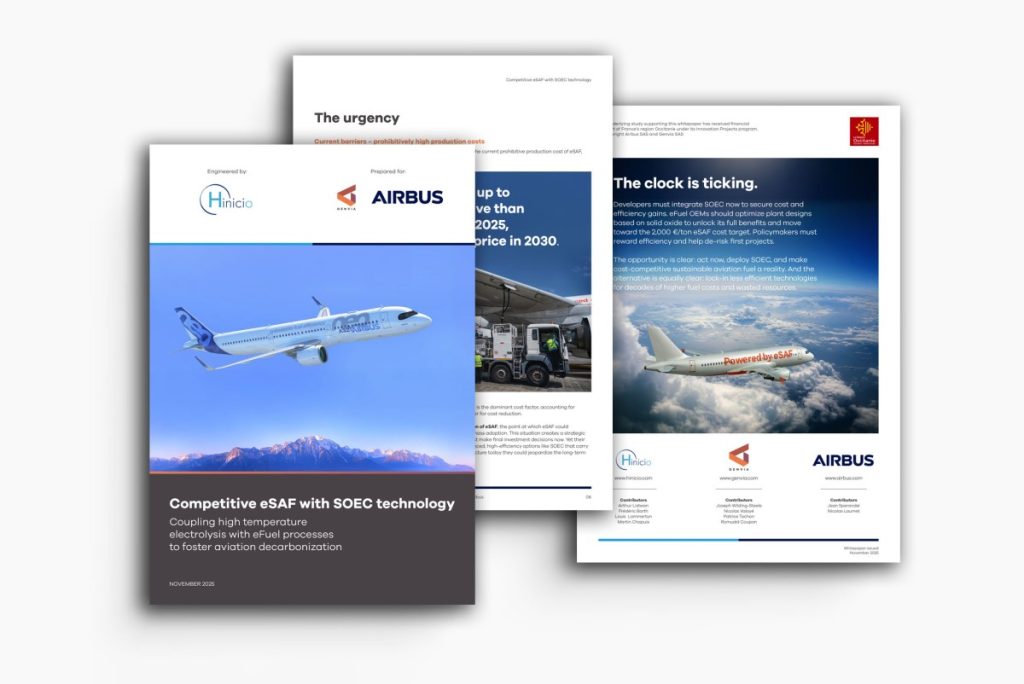 Download our published work
Download our published work
 Insight in the Decarbonization of Oil Refining by Integrating High-Temperature Electrolysis
Insight in the Decarbonization of Oil Refining by Integrating High-Temperature Electrolysis
High-temperature electrolysis of steam is one of the most energy-efficient techniques for producing hydrogen. Coupling the process with conventional oil refining plant can help this industry lowers its carbon footprint by using the low-carbon hydrogen instead of hydrogen derived from fossil resources.
This study explores the potential of replacing steam methane reformers with high-temperature electrolysis, utilizing heat sources from a midsize refinery.
2025
Download Download
 High-Temperature Electrolysis Integrated with Direct Reduced Iron Process for Producing Low-Carbon Steel
High-Temperature Electrolysis Integrated with Direct Reduced Iron Process for Producing Low-Carbon Steel
High-temperature electrolysis (HTE) of steam is one of the most energy-efficient techniques for producing hydrogen. Coupling the process with a direct reduced iron (DRI) plant can help the steel industry lower its carbon footprint by using the low-carbon hydrogen as a reducing agent and fuel, instead of synthesis gas derived from either natural gas or coal. In this study we aim to predict the performance of an integrated DRI plant via process modelling and simulation. The integration of HTE significantly reduced the CO2 intensity of steel production.
2024
Download DownloadAs we want to have the most efficient and durable SOEC, an important focus for our R&D program, together with French research centers (CEA, CNRS), is working on the core of the electrolyser, the cells, thanks to Simulations and experimentations.
As we want to have the most efficient and durable SOEC, an important focus for our R&D program, together with French research centers (CEA), is working on the stacks, thanks to Engineering work, prototypes and manufacturing processes.
 Study of a glass-ceramic sealant over the stack lifetime
Study of a glass-ceramic sealant over the stack lifetime
The gas-tightness of the stack is a major issue in high temperature electrolysers used for hydrogen production. This paper presents the study and modelling of material crystallization allowing us to obtain a better description of the seal microstructure evolution during the stack operation.
2024
Download Download
 Model reduction approach applied to the thermal simulation of a solid oxide electrolysis stack
Model reduction approach applied to the thermal simulation of a solid oxide electrolysis stack
In this paper we aim to simulate the thermal behavior of a stack within a SOEC system using a Reduced Order Model approach (ROM) based on the proper orthogonal decomposition methodology [3]. A Full Order Model (FOM) has first been developed to calculate a large number of operations cases and to constitute a learning cases database.
2024
Download Download
 Thermal effects on polarisation curve in high compactness CEA stack
Thermal effects on polarisation curve in high compactness CEA stack
To facilitate the deployment of pre-industrial systems, CEA is dedicating considerable resources to scaling up its proprietary stack-based design and gaining deeper insights into optimizing its utilization. An experimental investigation is underway to explore these effects during hydrogen production.
2024
Download Download
 Gas-tightness studies at high temperature: application to SOE
Gas-tightness studies at high temperature: application to SOE
When designing industrial Solid Oxide Electrolysis systems, the gas-tightness of the inner parts and auxiliaries is a technical subject requiring dedicated attention. This paper addresses the general topic of the gas-tightness requirements and their impacts on systems and stacks design and operation.
2024
Download DownloadIn order to maximise the overall SOEC efficiency, R&D works are carried out, together with French research centers (CEA, CNRS), in order to optimise the thermal coupling with industrial processes. GENVIA is also involved in a European Project (PRESSHYOUS) to investigate a pressurized SOEC.
 Heat storage for the coupling of Waste Heat Recovery and hydrogen production in a Solid-Oxide electrolyser
Heat storage for the coupling of Waste Heat Recovery and hydrogen production in a Solid-Oxide electrolyser
Efficient operation of a Solid-oxide steam electrolyser requires a well-designed heat management system to heat the entering streams up to the electrolyser temperature (700-850°C). The different components are dimensioned and modeled using Dymola software. The control strategy is studied and optimized to maintain a stable electrolyser operation.
2024
Download Download
 Pressurized hydrogen produced by high temperature steam electrolysis: the European project PressHyous
Pressurized hydrogen produced by high temperature steam electrolysis: the European project PressHyous
PressHyous, an EU R&D project funded by the Clean Hydrogen partnership, is aiming to produce low-carbon pressurised H2 at reduced cost. It will prove the concept through the operation of a 20 kWe pressurised lab-scale device (eq. 13.5 kg of pressurized H2/day). To complement the practical testing of the PressHyous concepts, the project will deliver model-based insights for H2 production under pressure for up to 5 identified use cases.
2024
Download Download
 Recent Highlights on Solid Oxide Cells, Stacks and Modules Developments at CEA
Recent Highlights on Solid Oxide Cells, Stacks and Modules Developments at CEA
CEA is working on the whole value chain of SOC technology, from cell development and optimisation to module design and operation through stack upscaling. Recent achievements on those aspects will be presented.
2023
Download Download
 Status of Electrolyser Development at GENVIA
Status of Electrolyser Development at GENVIA
The result of 15 years’ research and development from the French Atomic and Alternative Energies Commission (CEA), Genvia’s high-performance electrolyser and fuel cell systems are based on a proprietary solid oxide stack technology that offers improved efficiency, process reversibility and fuel versatility over competing approaches. In this publication, the strategic road map of GENVIA for SOEC technology development and
manufacturing is described.
2022
Download Download

 Download our published work
Download our published work 